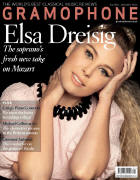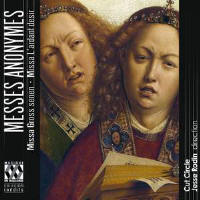Texte paru dans: / Appeared in: |
|
|
Outil de traduction |
|
|
Reviewer: Fabrice Fitch Anonymous Renaissance Mass cycles rarely make it into the catalogue, not even those that have helped form our understanding of the genre in its infancy (attribute such a work to a named composer and it’s in with a chance; the English Caput cycle is a rare exception). The two Masses recorded here have long been known to specialists but have never been recorded. Gross senen is thought to date from about the 1460s and L’ardant desir may be a decade or so later. The first is the more polished of the two but the second is more ambitious and arguably more interesting, even though its flaws are more audible (I’m reminded of a friend’s comment that ‘any idiot can write a good Kyrie, but it takes a great composer to write a good Credo’). To my ear, both composers (assuming they are different, which is very likely) knew their Busnoys, and neither is likely to have been very much younger. In addition, the L’ardant desir composer devised some very ingenious tricks for transforming his source material. This doesn’t translate audibly, but it adds to our picture of the intellectual environment in which the Mass was composed: it’s full of ideas. It needs saying how good it is to be able to hear this music at all, let alone in performances of this calibre. Cut Circle’s approach is almost radically different to the one taken in their earlier Mass recordings (Dufay, Josquin, de Orto): rather than two voices on each part there is just one, and the contrast between them is often striking. Not that homogeneity goes out the window (they sound very well together), but the emphasis on individual lines comes across more sharply, sometimes aggressively so. (The altus singer’s tone might best be described as ‘lusty’, and though not consistently in Graindelavoix territory, it is at times overly present, especially at final cadences. But as one who so often laments the reluctance of latter-day ensembles to take risks, I can’t complain … too much.) The greatest virtue of these performances is the clarity of formal articulation, which allows details to speak eloquently. Not only are the differences between the two works easy to hear but so is the way Cut Circle approach each one. They sound more assured in Gross senen; the more intricate passages of L’ardant desir are trickier to negotiate and there’s a hint of strain at times, as though the desired intensity eludes them. That’s also to do with the range of the top voice, which is a bit lower than in Gross senen and forces issues of balance and (yes) stamina for the whole ensemble. But the bustle of counterpoint towards the end of the final Agnus Dei is truly invigorating, reminiscent of Busnoys at his most truculent. The recent turn that Jesse Rodin’s ensemble has taken (since its recording of Ockeghem’s complete songs – 1/21) is intriguing and felicitous. I hope that its current line-up will endure and give us much more. |
|




